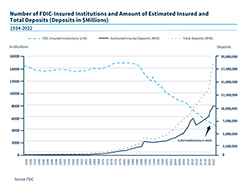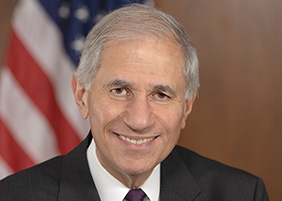March 14, 2020
Because of the COVID-19 pandemic, the FDIC institutes mandatory telework at all of its facilities. Two days later, the FDIC changes its normal policy of conducting onsite examinations to one where the vast majority of supervisory activity is conducted offsite.
September 2020
As of June 30, 2020, the DIF's reserve ratio dropped to 1.30 percent, below the statutory minimum of 1.35 percent, because of extraordinary insured deposit growth. The FDIC therefore adopted a Restoration Plan to restore the DIF reserve ratio to at least 1.35 percent within eight years, absent extraordinary circumstances, as required by law. The FDIC maintains its current assessment rate schedule and estimates that the reserve ratio will be restored without further action by the FDIC.
December 31, 2020
There are approximately 5,000 FDIC-insured institutions with estimated insured deposits of about $9 trillion.

Chart of the number of FDIC-insured institutions and amount of estimated insured and total deposits - 2020
January 5, 2023

March 10, 2023
Silicon Valley Bank, Santa Clara, CA (SVB) fails, very unusually, during business hours, following a bank run by uninsured depositors, who made up the vast majority of the bank’s depositors. On March 9, the bank had experienced a deposit outflow of over $40 billion, and the bank expected more than $100 billion in additional outflows the next day, leading to the bank’s closure by state banking authorities. With $209 billion in assets as of the quarter before its failure, the bank is the 3rd largest failure in FDIC history. The FDIC establishes a Deposit Insurance National Bank (DINB) to facilitate the resolution of the bank, and make deposits available to insured depositors. On March 12, the FDIC, the Federal Reserve and the Treasury announce that, under a systemic risk exception and to maintain confidence in the banking system, all deposits in SVB, both insured and uninsured, will be covered by the FDIC. Any losses to the Deposit Insurance Fund incurred as a result of the protection of uninsured depositors will be recovered by a special assessment on the industry as required by law. On March 13, the FDIC announces the creation of a bridge bank to facilitate the resolution of SVB. Two weeks later, on March 26, the FDIC announces that First-Citizens Bank and Trust Company, Raleigh, NC will assume all the deposits and loans of the bridge bank, and that the transaction has an estimated cost to the Deposit Insurance Fund of approximately $20 billion.
For the Federal Reserve Board's analysis of the failure, see https://www.federalreserve.gov/publications/files/svb-review-20230428.pdf .
March 12, 2023
Signature Bank, New York, NY fails after a bank run. Like Silicon Valley Bank, Signature Bank also had a very high proportion of uninsured deposits. With $100 billion in assets as of the quarter before failure, the bank is the 4th largest failure in FDIC history. The FDIC creates a bridge bank to facilitate its resolution. Signature Bank, like Silicon Valley Bank, is also covered by a systemic risk exception so that all deposits in the bank are protected and so any losses to the Deposit Insurance Fund incurred as a result of the protection of uninsured depositors will be recovered by a special assessment on the industry as required by law. On March 19, the FDIC announced the Flagstar Bank, National Association, Hicksville, NY entered into an agreement to assume substantially all the deposits and certain loan portfolios of the bridge bank. At this time, the FDIC estimates the cost of the Signature Bank’s failure to be approximately $2.5 billion.
For the FDIC's analysis of the failure, see https://www.fdic.gov/news/press-releases/2023/pr23033.html .March 12, 2023
In order to ensure that banks have the ability to meet the needs of their depositors, the Federal Reserve creates a new Bank Term Funding Program which will offer loans of up to one year to banks that pledge various types of collateral, allowing banks to borrow at par against for securities that could have a market value well below par. Banks would therefore not have to sell securities that had declined in value due to the changed interest rate environment.
April 24, 2023
First Republic Bank, San Francisco CA, fails. With approximately $229 billion in assets, it is the 2nd largest failure in FDIC history, behind Washington Mutual, which failed in 2008. During the first three months of 2023, the bank experienced deposit outflows of more than $100 billion. The FDIC enters into a transaction with JP Morgan Chase Bank, National Association, whereby the bank assumes all of the deposits and most of the assets of the failed bank. In addition, the FDIC and JP Morgan Chase also enter into a loss-share transaction on certain loans the bank purchased from First Republic Bank. The FDIC estimates that the cost to the Deposit Insurance Fund will be approximately $13 billion.
November 16, 2023
The FDIC’s Board approves a final rule to implement a special assessment to recover the loss of approximately $16.3 billion to the Deposit Insurance Fund associated with protecting uninsured depositors in the failed institutions Silicon Valley Bank and Signature Bank. The special assessment is designed to apply to the types of banking organizations that benefitted most from the protection of uninsured depositors. The FDIC will collect the special assessment at an annual rate of 13.4 basis points beginning with the first quarterly assessment period of 2024 and it is anticipated the special assessments will be collected for a total of eight quarterly assessment periods. The FDIC estimates that 114 banking organizations will be subject to the special assessment.
https://www.fdic.gov/news/press-releases/2023/pr23092.html
The estimated loss attributable to the protection of uninsured depositors will be periodically adjusted. As of year-end 2023 the FDIC increased the estimate from $16.3 billion to $20.4 billion.
See https://www.fdic.gov/about/financial-reports/reports/2023annualreport/ar23section5.pdf, 140.
December 20, 2023
The FDIC’s Board adopts a final rule governing the use of the official FDIC signs. The FDIC’s black and gold official sign had been displayed at branch teller windows since the 1930s, giving a bank’s customers confidence that their deposited funds were safe. With the advent of new options for consumers and depositors to deposit their money and how they can access banking products and services, the FDIC establishes a new black and navy official FDIC digital sign. Beginning in 2025, banks will be required to display the official digital sign near the name of the bank on all bank websites and mobile applications, as well as on certain automated teller machines. The rule also clarifies the FDIC’s regulations on misrepresentations of deposit insurance coverage.

